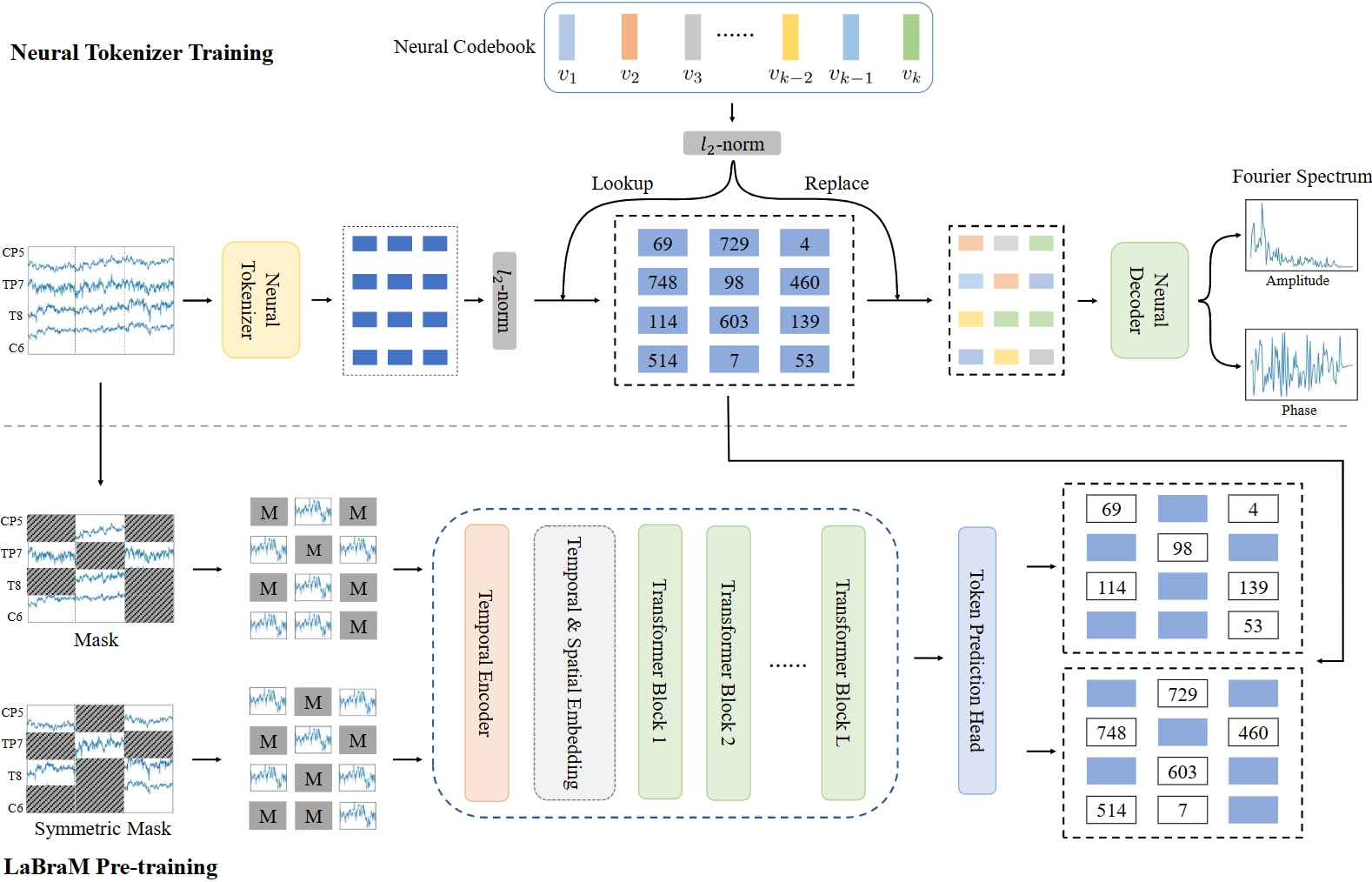This is the official implementation of our ICLR 2024 paper "Large Brain Model for Learning Generic Representations with Tremendous EEG Data in BCI".
The current electroencephalogram (EEG) based deep learning models are typically designed for specific datasets and applications in brain-computer interaction (BCI), limiting the scale of the models and thus diminishing their perceptual capabilities and generalizability. Recently, Large Language Models (LLMs) have achieved unprecedented success in text processing, prompting us to explore the capabilities of Large EEG Models (LEMs). We hope that LEMs can break through the limitations of different task types of EEG datasets, and obtain universal perceptual capabilities of EEG signals through unsupervised pre-training. Then the models can be fine-tuned for different downstream tasks. However, compared to text data, the volume of EEG datasets is generally small and the format varies widely. For example, there can be mismatched numbers of electrodes, unequal length data samples, varied task designs, and low signal-to-noise ratio. To overcome these challenges, we propose a unified foundation model for EEG called Large Brain Model (LaBraM). LaBraM enables cross-dataset learning by segmenting the EEG signals into EEG channel patches. Vector-quantized neural spectrum prediction is used to train a semantically rich neural tokenizer that encodes continuous raw EEG channel patches into compact neural codes. We then pre-train neural Transformers by predicting the original neural codes for the masked EEG channel patches. The LaBraMs were pre-trained on about 2,500 hours of various types of EEG signals from around 20 datasets and validated on multiple different types of downstream tasks. Experiments on abnormal detection, event type classification, emotion recognition, and gait prediction show that our LaBraM outperforms all compared SOTA methods in their respective fields.
Install required packages:
conda create -n labram python=3.11
conda activate labram
conda install pytorch==2.0.1 torchvision==0.15.2 torchaudio==2.0.2 pytorch-cuda=11.8 -c pytorch -c nvidia
conda install tensorboardX
pip install -r requirements.txtYou should transfer raw EEG files (such as .cnt, .edf, .bdf, and so on) into hdf5-format files using the example code in dataset_maker/make_h5dataset_for_pretrain.py. Notably, you can also write your own codes for preprocessing EEG data. Make sure that the preprocessing is consistent with that of our paper, that is, removing useless channels, filtering between 0.1 Hz and 75 Hz, notch filtering of 50 Hz, resampling to 200 Hz, and setting the unit to
The neural tokenizer is trained by vector-quantized neural spectrum prediction. It is recommended to train it on platforms with 8 * NVIDIA GeForce RTX 3090 or better GPUs.
OMP_NUM_THREADS=1 torchrun --nnodes=1 --nproc_per_node=8 run_vqnsp_training.py \
--output_dir ./checkpoints/vqnsp/ \
--log_dir ./log/vqnsp/ \
--model vqnsp_encoder_base_decoder_3x200x12 \
--codebook_n_emd 8192 \
--codebook_emd_dim 64 \
--quantize_kmeans_init \
--batch_size 128 \
--opt adamw \
--opt_betas 0.9 0.99 \
--weight_decay 1e-4 \
--warmup_epochs 10 \
--epochs 100 \
--save_ckpt_freq 20 We pre-train LaBraM by predicting the original neural codes for the masked EEG channel patches.
OMP_NUM_THREADS=1 torchrun --nnodes=1 --nproc_per_node=8 run_labram_pretraining.py \
--output_dir ./checkpoints/labram_base \
--log_dir ./log/labram_base \
--model labram_base_patch200_1600_8k_vocab \
--tokenizer_model vqnsp_encoder_base_decoder_3x200x12 \
--tokenizer_weight ./checkpoints/vqnsp.pth \
--batch_size 64 \
--lr 5e-4 \
--warmup_epochs 5 \
--clip_grad 3.0 \
--drop_path 0. \
--layer_scale_init_value 0.1 \
--opt_betas 0.9 0.98 \
--opt_eps 1e-8 \
--epochs 50 \
--save_ckpt_freq 5 \
--codebook_dim 64 \
--gradient_accumulation_steps 1Before fine-tuning, use the code in dataset_maker/(make_TUAB.py, make_TUEV.py) to preprocess the downstream datasets as well as split data into training, validation, and test set. Notably you are encouraged to try different hyperparameters, such as the learning rate and warmup_epochs which can largely influence the final performance, to get better results. Here is the hyperparameter we used in the paper:
OMP_NUM_THREADS=1 torchrun --nnodes=1 --nproc_per_node=8 run_class_finetuning.py \
--output_dir ./checkpoints/finetune_tuab_base/ \
--log_dir ./log/finetune_tuab_base \
--model labram_base_patch200_200 \
--finetune ./checkpoints/labram-base.pth \
--weight_decay 0.05 \
--batch_size 64 \
--lr 5e-4 \
--update_freq 1 \
--warmup_epochs 3 \
--epochs 30 \
--layer_decay 0.65 \
--drop_path 0.1 \
--dist_eval \
--save_ckpt_freq 5 \
--disable_rel_pos_bias \
--abs_pos_emb \
--dataset TUAB \
--disable_qkv_bias \
--seed 0If you find our paper/code useful, please consider citing our work:
@inproceedings{
jiang2024large,
title={Large Brain Model for Learning Generic Representations with Tremendous {EEG} Data in {BCI}},
author={Wei-Bang Jiang and Li-Ming Zhao and Bao-Liang Lu},
booktitle={The Twelfth International Conference on Learning Representations},
year={2024},
url={https://openreview.net/forum?id=QzTpTRVtrP}
}
